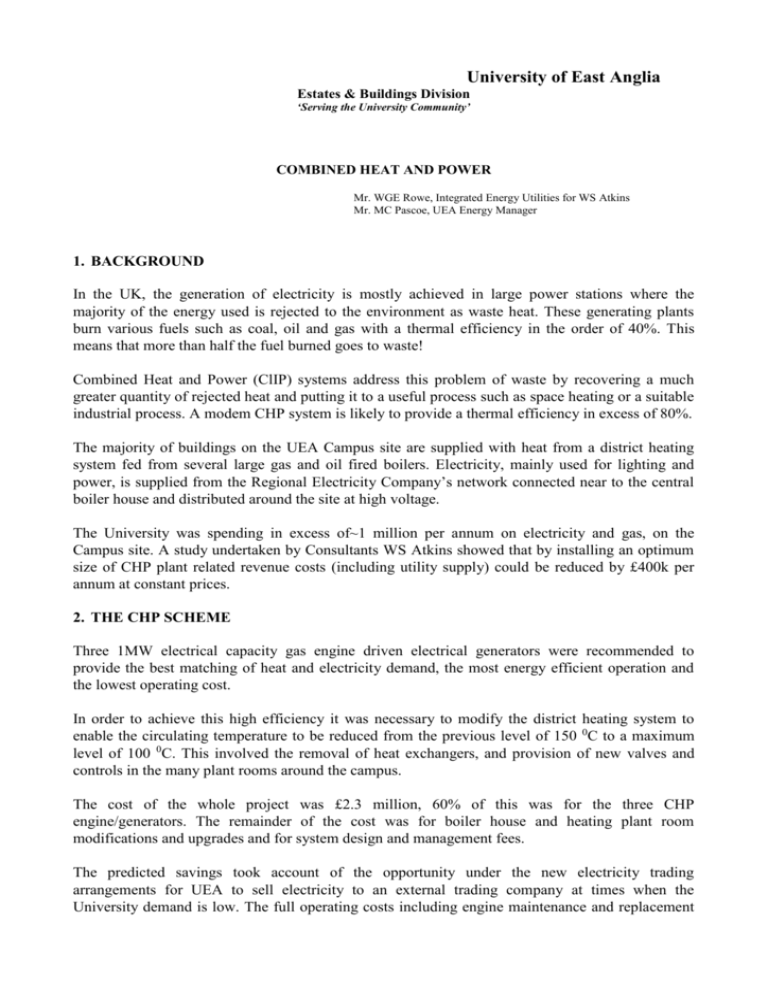University of East Anglia
advertisement

University of East Anglia Estates & Buildings Division ‘Serving the University Community’ COMBINED HEAT AND POWER Mr. WGE Rowe, Integrated Energy Utilities for WS Atkins Mr. MC Pascoe, UEA Energy Manager 1. BACKGROUND In the UK, the generation of electricity is mostly achieved in large power stations where the majority of the energy used is rejected to the environment as waste heat. These generating plants burn various fuels such as coal, oil and gas with a thermal efficiency in the order of 40%. This means that more than half the fuel burned goes to waste! Combined Heat and Power (ClIP) systems address this problem of waste by recovering a much greater quantity of rejected heat and putting it to a useful process such as space heating or a suitable industrial process. A modem CHP system is likely to provide a thermal efficiency in excess of 80%. The majority of buildings on the UEA Campus site are supplied with heat from a district heating system fed from several large gas and oil fired boilers. Electricity, mainly used for lighting and power, is supplied from the Regional Electricity Company’s network connected near to the central boiler house and distributed around the site at high voltage. The University was spending in excess of~1 million per annum on electricity and gas, on the Campus site. A study undertaken by Consultants WS Atkins showed that by installing an optimum size of CHP plant related revenue costs (including utility supply) could be reduced by £400k per annum at constant prices. 2. THE CHP SCHEME Three 1MW electrical capacity gas engine driven electrical generators were recommended to provide the best matching of heat and electricity demand, the most energy efficient operation and the lowest operating cost. In order to achieve this high efficiency it was necessary to modify the district heating system to enable the circulating temperature to be reduced from the previous level of 150 0C to a maximum level of 100 0C. This involved the removal of heat exchangers, and provision of new valves and controls in the many plant rooms around the campus. The cost of the whole project was £2.3 million, 60% of this was for the three CHP engine/generators. The remainder of the cost was for boiler house and heating plant room modifications and upgrades and for system design and management fees. The predicted savings took account of the opportunity under the new electricity trading arrangements for UEA to sell electricity to an external trading company at times when the University demand is low. The full operating costs including engine maintenance and replacement of all wear parts by the suppliers over an a Contract period of 12 years and including the reduction in the gas supply tariff resulting from a higher continuous demand. 3. ANNUAL HEAT & ELECTRICITY COST SAVING Fig I shows the pre-CHP fuel and electricity operating expenditure in each month over a 12 month period; the predicted costs with CHP and the recent out-turn expenditure The results show improvements over the estimated performance and costs also including CHP maintenance costs and system maintenance cost savings resulting from the modifications and upgrades. It should be noted that in January 2001 the price of gas increased by 86%. Despite this the scheme is still in profit compared with the case of no CHP and paying Climate Change Levy. . 4. SPIN-OFF BENEFITS FROM THE CHP SCHEME The introduction of CHP also provides numerous spin-off benefits to the University: The reduction of the heating system water circulating temperature reduces thermal losses and increase the life of component parts, improve reliability and reduce maintenance costs. The less arduous temperature and pressure of operation for the district heating system means that it no longer falls within statutory inspection regulations. Consequently the University saves on inspection fees, and the complete shutdown of the district heating system (for inspection and maintenance-related purposes) has become unnecessary. *. The boiler house which is more than 30 years old has been substantially refurbished as part of the ClIP implementation with a new low pressure unit, electrical control panels and the system heat distribution pumps. The boilers were unlikely to last many more years at the current levels of use. The ClIP scheme greatly reduces their operational hours and the lower operating temperature and pressure will significantly extend their working life. In the thirty heating plant rooms around the Campus, the existing items of equipment (such as calorifier tube bundles, three way control valves and high limit valves) were already in need of replacement or refurbishment in the short-medium term. These items have been replaced within the capital cost of the CLIP scheme, including the removal of a considerable quantity of asbestos insulation. The maintenance cost reduction resulting from the renewal of equipment is estimated at £50k per annum. Some occupied rooms adjacent to plant rooms have suffered from excessive heat gains from radiating surfaces on items of equipment. The use of lower primary temperatures and removal of the large surface area, attributable to calorifiers, has alleviated this problem. The alternatives, previously considered were to spend money on additional insulation and air conditioning. Previous problems with poor heat distribution to buildings at the extremities of the heat distribution system have been eliminated by converting the system from constant to variable flow operation. Furthermore the modifications have created spare system capacity which will enable new buildings in future to be added to the system. • Connection of the new Sports Park has alleviated the need for it to fund its own boiler plant and CHP unit has gained from economies of scale. A small CHP for the SportsPark would probably have cost in the order of~60k and attracted separate maintenance and replacement liabilities. The additional future loading from new buildings or new facilities on the site would improve the financial viability of the CHP scheme, as the increased base load heat demand improves the ClIP utilisation. Expansion is already being planned and new connections to the site district heating system have been made since the CHP system was commissioned in 1998. The original district heating system was reliant on one main circulating pump with no full standby facility. This pump had never been overhauled and as such represented a risk to the security of site heating supplies. A new low energy variable speed pumping station including full standby capacity was provided within the ClIP scheme. • The change to a variable volume heat distribution system including the removal of secondary pumping to air heater batteries is estimated to have reduced the electrical power needed for pumping at a cost equivalent of £8,500 per annum. Heating controls for many buildings were outdated and have been replaced with a modern computer-based Building Management System interface as part of the ClIP project. This has produced better control information (to the Estates Division) about defects and data to optimise the heating of those buildings. CHP is associated with environmental benefits which can be well illustrated by reference to the reduction in the resultant emission of carbon dioxide gas. Carbon dioxide is one of the prime contributors to global warming, caused by the excessive greenhouse effect. CHP will reduce the CO2 emission resulting from the supply of heat and electricity to the Campus buildings by more than 35% (8,600 tonne per annum). This represents a saving of 25% on the levels of emission in 1990 (despite an increase in electricity use of 29% since then). As a University with a special interest in the environment, UEA are therefore able to demonstrate a how ClIP makes a significant contribution towards environmental improvement. The Government has been looking for a 15% improvement within government buildings in recent years; and has referred to CHP as one means of achieving desired results. 5. IMPLEMENTATION PROGRAM The feasibility study was carried out in April/May 97. A report and recommendation was made UEA Estates and Buildings Division in Aug 97. UEA entered into the design and project management contract with Atkins in November 97 Construction works commenced in May 98 allowing boiler house and plant room system modification work including site preparation to accommodate the ClIP generators to be carried out during the summer period. The installation of the CHP generators commenced in Nov 98 and were commissioned during January/February 99. 6. PROJECT FINANCING A financial appraisal of the project was undertaken by the UEA Director of Finance. The appraisal focused on the three options of leaving as status quo, changing the district-heating infrastructure to run at low temperature and thirdly to install CHP, which would also necessitate the infrastructure modifications. The appraisal assumes an inflation rate of 3% overall and used a 6% discount rate. This revealed that, on a Net Present Value Basis, the third option of installing CHP along with necessary infrastructure changes was the most cost effective. All the capital cost was funded by leasing. The leasing costs are the first call on the savings made in the Premises energy budget. As with conventional external borrowing additional leasing for ClIP counted against the borrowing threshold as laid down by the Higher Education Funding Council (HEFC). The Director of Finance obtained approval for the relatively modest increase in the threshold. For commercial reasons the University uses a subsidiary company, UEA Utilities, through which all power and water is supplied. 7. DESIGN & CONSTRUCTION CONTRACT ARRANGEMENT Projects of this type involving both construction and performance risk are often contracted out to a third party in an agreement where the system owner only obtains a share in the cost benefit or a cost saving heat and electricity tariff. The definitive study method used by WS Atkins however in which ClIP plant and system operation were accurately modelled enabled the system performance and all costs and incomes to be clearly identified, and a clear demarcation given of the contractual responsibility for the Engineer / Project Manager and the for ClIP generator supplier. The Atkins Feasibility Study was therefore incorporated into their engineering design and project management agreement in an arrangement which enabled all the operating cost benefits from ClIP to be retained by the University. Furthermore as Atkins were to provide detailed working drawings and specifications for all parts of the work it was possible, working in close liaison with the University management staff, to arrange competitive tendering and contracts directly with specialist suppliers and installers thereby saving the margins and contingencies which would be included under the alternative main contractor arrangement. The working relationships between the Engineer, the Estates Management Team and the various suppliers and contractors listed in Section 8 has worked well and the contractual arrangement has proved to be successful with the project coming in on time and budget and slightly exceeding performance estimates. Indeed several additional upgrades were provided within the allocated funds. 8. CONTRACTORS & MAIN SUPPLIERS CHP GENERATORS & HV ELECTRICAL EQUIPMENT BOILERHOUSE & PLANTROOM PIPE WORK PLANTROOM PIPE WORK BOILERHOUSE AND HEAT DISTRIBUTION SYSTEM CONTROL & MONITORING BOILER & GENERATOR FLUES ASBESTOS REMOVAL & PIPEWORK INSULATION MAIN MATERIAL SUPPLIERS - -- MAIN PUMP SUPPLIER COOLING & HEATING COILS -- COOLING FANS HEAT DISTRIBUTION CONTROL VALVES SCAFFOLDING Countryman Co-Gen using Deutz Engines Pruce Newman Pipework Ltd. [also acting as Principal Health & Safety Contractor] West Norfolk Engineering Aqua Control Services Ltd Ritevent East Coast Insulations BSS John Gaunt Pump Supplies Eurocoils Elta Fans Ltd Samson Controls Ltd Eastern Counties Scaffolding








